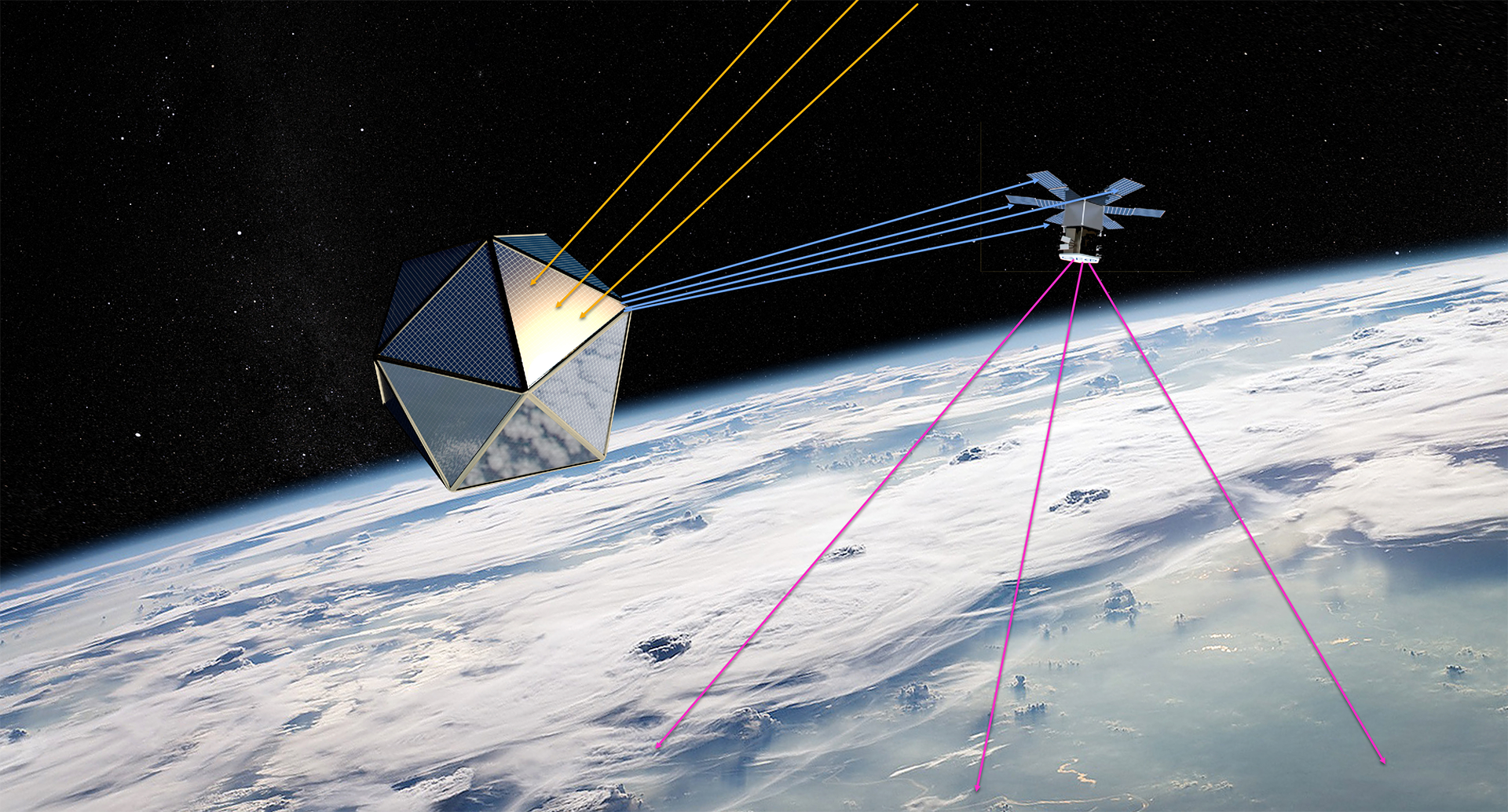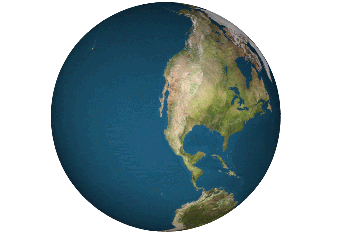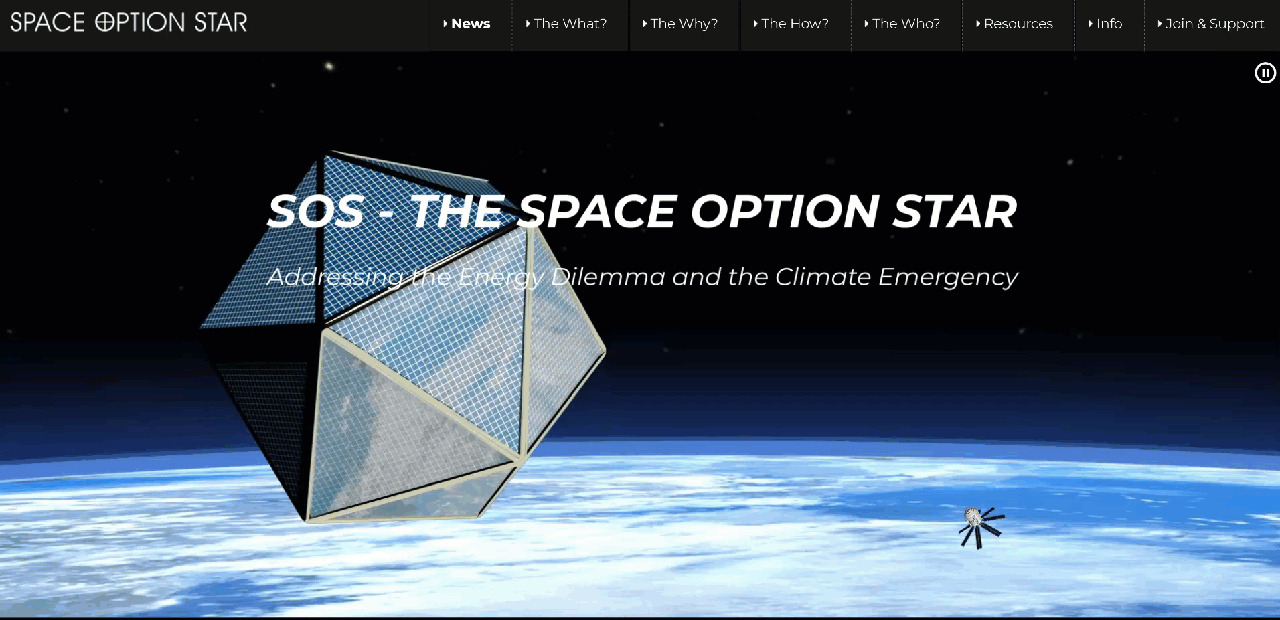WHAT'S NEXT? NEW SPACE MISSION IDEAS AND CONCEPTS
European Space Agency Call for Mission Ideas
SPACE RESOURCES & INFRASTRUCTURE GROUP
SOS - Space Option Star Selected in ESA Call for Mission Ideas
201 ideas were submitted in ESA's 2020 call for new mission ideas.
A number were selected for further development and have been grouped together with related concepts.
Of the published concepts, 4 energy from space projects were selected including ESA's own space power proposal.
Eventually 3-5 missions will be chosen by ESA for implementation.
Arthur R. Woods
Co-authors: Marco C. Bernasconi, Théotime Coudray, Dmitrijis Gasperovics
The Space Option Star (SOS) is a Space Solar Power (SSP) demonstrator and represents a logical early step for any Space-Based Solar Power (SBSP) development program. The SOS mission has a dual purpose: first, its technical mission represents an in situ demonstration of SBSP technologies and, secondly, its communication mission is to raise public awareness about the potential of the Space Energy Option to address the Energy Dilemma and the Climate Emergency facing the world population.
MISSION STATEMENT
SOS - Addressing the Energy Dilemma and the Climate Emergency
Humanity is facing an imminent Energy Dilemma in that the limited proven reserves of fossil fuels could reach exhaustion levels at mid-century and none of the current alternative terrestrial energy options – nuclear – wind - ground solar (PV) – can be sufficiently scaled to achieve the goal of divesting from fossil fuels by the year 2050 as is being called for by the United Nations, the European Union and numerous organizations to address the Climate Emergency.
The Space Energy Option is the only near term technically feasible and scalable alternative currently available to humanity to divest from fossil fuels while meeting its future energy needs. According to the BP Statistical Review of World Energy 2019 which lists World Primary Energy Consumption by region and country and by energy source, current worldwide energy consumption is 13,865 Mtoe which, when converted to SI units, corresponds to approximately 18.4 terawatts (TW), of which 15.6 TW (85%) comes from fossil fuels, 1.26 TW (7%) from hydroelectricity, 811 gigawatts (GW) (4%) from nuclear power and 745 GW (4%) from renewables. As illustration , in order to replace current fossil fuel usage of 15.6 TW with nuclear power (assuming a 90% availability for the plants) would require the deployment of up to 17,530 new 1-GW nuclear reactors. On the average then, for the next 30 years, 572 new power plants would have to go on line each year – in other words, adding 1½ new 1-GW reactors each day. Wind and solar photovoltaic (PV) generators have significantly lower availability and their inherent intermittency and storage aspects make it necessary to deploy multiples of their equivalent rated (peak) power levels to equal the output, e.g., of nuclear power systems. For wind, the generating capacity needs to be some 3.35 times higher and for solar PV, 6-7 times higher. Thus, to replace 2018 fossil fuel use with wind and ground solar, no less than 65 TW (depending on the assumed wind/PV mix) of power generating capacity from these two renewable sources would need to be installed - if this electricity could be stored and distributed efficiently which is currently not the case. Thus, all terrestrial energy solutions seem highly unlikely to meet the climate goals and to supply sufficient energy for powering civilization in the years ahead. Therefore to address the Energy Dilemma and the Climate Emergency and to make the Space Energy Option viable, a determined space solar power development program is necessary. The Space Option Star - an in situ demonstration of SBSP technologies and a powerful communication event - is an important first step.
HIGH-LEVEL MISSION REQUIREMENTS
Just Do it!
With the goal to divest from carbon fossil fuels by the year 2050, the most outstanding high-level mission requirement would be a strong commitment by ESA to embark on a determined space solar power development program. An official ESA policy decision to develop a space energy solution addressing the Energy Dilemma and the Climate Emergency would be the subject of numerous media inquiries and discussion from all sectors of society. Fast tracking the Space Option Star towards an early in situ demonstration of SBSP technologies would immediately activate its communication mission which would continue throughout its development and realization phases. As each phase of its realization program would be subject to much public scrutiny and attention, this would likely catalyze a powerful public outreach activity.
University students should be brought into the program early on to emphasize and promote the STEM/STEAM educational aspects - not only in technological areas but also in societal matters. Likewise, private partners should be identified and brought into the program as soon as possible. As a determined space solar program would not be inexpensive in the early stages, ESA member nations could be motivated to increase their contributions as energy security becomes an increasingly higher priority and as the benefits of space solar power would be mutually shared.
MISSION ARCHITECTURE
Initial Technical Considerations
The space segment of the Space Option Star would perform an early demonstration of the basic technological elements of SBSP. Electricity generated by the icosahedron's solar arrays would flow to co-located microwave transmitters to beam power toward a companion spacecraft, which will then use this power to transmit video and other interactive communications from orbit to public locations around the world such as art and science museums and schools.

SOS - in situ SBSP demonstration
The suggested configuration of the SOS project elements builds upon a variety of studies (of similar aim) and technological concepts. For instance, the “power satellite” requires a (relatively) large size to collect sufficient solar power and to support a representative high-gain transmitter, as will be the case for operational items. On the other hand, in order to reduce costs, simplified designs are preferred. Here, the icosahedron geometry approximates an omnidirectional object, with the Sun illuminating similar surface areas at any given time, thus removing the need for an (active) attitude control system. Similarly, array antennas can track the receiver's position electronically, eliminating dedicated steering mechanisms. Either the solar panel PV facets will be manufactured as a hybrid with the antennas integrated in the photovoltaic membrane, or the transmitters will be integrated into the icosahedron structure. These would be controlled and coordinated by an array of interconnected computer chips that would track and focus the WPT beam onto the auxiliary spacecraft.
The Space Option Star will utilize an inflatable laminated membrane technology incorporating a thin-film photovoltaic outer surface. Once in orbit, the reflective, faceted shape of the Space Option Star will reflect sunlight as it rotates causing it to appear as a blinking star in the night sky for a period of approximately one month. In addition to the visibility aspects which will make Space Option Star a significant global communication event available to much of the world’s population, interactive components will enable communication with Space Option Star at public locations around the world such as art and science museums and schools. The technical mission of the Space Option Star will be to collect sunlight, transform it into electrical energy and then transmit this energy via a concentrated beam to provide power for an auxiliary, unattached object in orbit which will then use this power to communicate with the Earth.
As such, the Space Option Star will be an early in situ demonstrator of WPT. Last but not least, the Space Option Star will be developed as commercial investment opportunity involving a consortium of companies, institutions and individuals with the goal that the obtained proprietary knowledge and experience can be applied by the shareholders to making the idea of Space-Based Solar Power (SBSP) for space and for Earth a commercial reality. In this context the Space Option Star will be an interdisciplinary, multi-dimensional art, science, technology and educational project designed to inform and excite the world population about the importance and urgency of implementing the Space Energy Option and the many advantages of using space technology to meet many of the growing essential needs of the humanity as well being an example of the inherent commercial opportunities involved in space development.

The choice of this geometry is further supported by various factors, beginning with its classical simplicity: As one of the five Platonic solids, it is composed of 20 triangular facets, with 30 sides and 12 vertices. Vertices and sides are realized as nodes and tubular struts that form a skeleton supporting the membrane-like facets. As the satellite tumbles, the flat triangle's surfaces will reflect sunlight causing it to appear in the night sky as a blinking star. This way, the SOS would be visible to much of the world’s population during its limited orbital lifetime. This would fulfill the second mission objective which is to alert the world population and its leaders to a space solution to the Energy Dilemma and the Climate Emergency. Interestingly, Buckminster Fuller used the icosahedron for a projection of the world map which he believed was less distorted than the standard Mercator projection.

The Dymaxion map by Buckminster Fuller - A projection of the "One Island Earth" onto an icosahedron
https://en.wikipedia.org/wiki/Dymaxion_map
In 2003, the European Space Agency contracted a study (ESA Contract No.16188/02/NL/MV) to re-examine the technology for large expandable structures for the purpose of celebrating the 2006 Winter Olympics. This study included the examination in some technical detail of a large icosahedron to be built utilizing the chemically rigidized expandable structures (CRES) technology that had been under development in the United States and in Europe for over thirty years, although not yet used for a space structure of this dimension.
The above-mentioned study looked at the size, the mass, and the visibility of such an icosahedron with a 100 meter extension. It was determined that such a “star” would reach a magnitude of about -4.4 (which would correspond to Venus at its brightest), with orbits that allow a lifetime of approximately 30 days. Indeed, an 85-m sphere ought to reach -4.4 in magnitude at a slant range from a 760-km orbit; an equivalent icosahedron's lifetime estimate comes to some 24 days. The initial technical definition of the SOS is primarily based on using CRES technology although additive manufacturing technologies may also be considered and/or employed.
The SOS encompasses several important aspects.
- SOS will be an early in situ demonstration of the basic SBSP technologies.
- SOS will stimulate the further development of expandable structures and/or additive manufacturing technologies for very large space structures that have been under development for a number a years but not deployed at this scale.
- SOS "Space-to-Earth" interactions will involve the public via schools and museums as well as the social media.
- SOS will be a visible "star" (100 meters in diameter) and, as the largest single object ever deployed in space, it will have a high public outreach potential alerting the world to the Space Energy Option for addressing the Energy Dilemma and Climate Emergency.
- S.O.S. is commonly used as the international Morse code distress signal (· · · – – – · · ·). In addition to SOS being an acronym for the Space Option Star project, we are using this project to send the world and its leaders the message: “Save Our Spaceship” .
- If SOS should be realized as the first step of a determined space solar power program signifying a solution to the above issues is under development, it will provide "hope" for a more positive future for humanity on Earth and beyond.

Website: spaceoptionstar.space
RELEVANT RELATED ACTIVITIES
- Arthur R. Woods & Marco C. Bernasconi, 2020, SOS - The Space Option Star: Addressing the Energy Dilemma, To be published in Leonardo - The Journal of the International Society for the Arts, Sciences and Technology,
https://spaceoptionstar.space/pdf/SOS-The_Space_Option_Star_Addressing_the_Energy_Dilemma_leonardo_final.pdf - Marco C. Bernasconi & Arthur R. Woods, 1993, Implementing the Space Option: Elaboration & Dissemination of a New Rationale for Space: Part I: The Rationale, Part 2: The Space Option. Paper IAA.8.1-93-764 a & b presented at the 44th International Astronautical Congress
- V. Blandow, P. Schmidt, W. Weindorf, M. Zerta, W. Zittel, M. Bernasconi, P. Collins, T. Nordmann. T. Vontobel, and J. Guillet. Earth and space-based power generation systems - a comparison. LBST Final Report 17682/03/NL/EC, European Space Agency, the Advanced Concepts Team, 2004
- Marco C. Bernasconi & Arthur R. Woods, 2009 , Lights in the Sky: Membrane Structures for Art in Space, International Conference on Textile Composites and Inflatable Structures, Structural Membranes 2009, E. Oñate, and B. Kröplin, (Eds) © CIMNE, Barcelona, Spain
https://thespaceoption.com/publications/Lights_in_the_sky_PPH-09-078-1.pdf - M.C. Bernasconi Consultants, Chemically Rigidized Expandable Structures, https://spaceoptionstar.space/chemically_rigidized_expandable_structures_mcbc.php
- Energy from Space Headlines:
https://spaceoptionstar.space/energy_from_space_headlines.php - Energy from Space Videos:
https://spaceoptionstar.space/energy_from_space_videos.php - Energy from Space Library:
https://spaceoptionstar.space/energy_from_space_books.php
DIRECT AND INDIRECT END USERS OR CUSTOMERS
The Space Energy Option
The Space Option concept was first introduced in 1993 (Bernasconi & Woods) and subsequently developed to provide a rationale for space activities. It is an evolutionary plan to meet the basic and anticipated needs of humanity with the addition of utilizing near Earth resources - not only for the in-situ support of science or exploration – but rather to apply these resources and/or their products for use on Earth at a conspicuous level. Most immediately, the harnessing of inexhaustible amounts of clean energy from space would replace humanity’s dependence on the continued use of fossil fuels while insuring its future energy needs.
Among all of nature’s diverse systems, energy is the principal driver of the increasing complexity of galaxies, stars, planets and life-forms in the expanding universe. Energy flows engendered largely by the expanding cosmos seem to be as universal as anything yet found in nature. Indeed, unlocking Earth's vast energy reserves enabled our species to embark on an industrial revolution leading to a technological civilization that is on the threshold of expanding permanently into the near cosmos. Earth's energy reserves are finite and inadequate for this next stage of a cultural and societal evolution which would enable humanity to become a spacefaring species.
Addressing the Energy Dilemma will require massive amounts of clean energy production for restoring the environment and meeting the energy needs of a growing population. Addressing the Climate Emergency will require massive amounts of clean energy production to adapt and survive a severe warming or cooling situation. Having sufficient energy would also allow our species to solve the water crisis, create new transportation fuels, reduce poverty, stimulate progress in the developing countries, sustain the world economy and to end conflict over finite energy resources. Harvesting inexhaustible energy in space and equally distributing it to all people of all nations would enable the entire population of Earth to have a prosperous and hopeful future in contrast to current policies and measures being implemented to permanently downsize society in order that humanity may continue to live within the confines of a planet defined by the limits of its atmosphere. Indeed, humanity's future on Earth is irrevocably linked to its future in space.
MISSION COST
€ 50 million
MISSION TIMELINE
Space Option Star Project Development
- Phase 0: Current. Space Option Star project definition, multi-media visualization, models and publications in various media.
- Phase 1: 1 year. Technical definition and feasibility assessment. Collaborations, cooperation and fundraising. Funding milestone: € 500,000
Phase 2: 1-2 years. On-ground integrated demonstration of CRES (Chemically Rigidizable Expandable Structure) technologies as applied to the Space Option Star and development of a functional exhibition object (5 to 8 meters dia.). Marketing and financial assessment together with public-private partnership implementation. Funding milestone: € 1,000,000
- Phase 3: 2-3 years. Space deployment of small prototype Space Option Star as a technology certification mission. Funding milestone: : € 5,000,000
- Phase 4: 3-5 years. In-orbit realization of a full-size Space Option Star with auxiliary spacecraft. Funding milestone: : € 30-50,000,000
SPACE MISSION APPLICATION AREA
Energy Security, Climate Change, Public Confidence in Space Activities, Outreach, Hope and Inspiration
BACKGROUND
Arthur R. Woods is an independent researcher and astronautical artist with two art projects successfully flown on the Russian Mir space station: the Cosmic Dancer in 1993 and Ars Ad Astra in 1995 in the context of EuroMir95. He is a member of the International Academy of Astronautics and co-chair of the Moon Village Association Cultural Considerations Working Group.
Dr. Marco C. Bernasconi is an expert in lightweight structures, astronautical systems, and astronautics and society assessments. During his career he gained extensive experience in the development of ultralight structure technologies and application designs. He has repeatedly served as a consultant to the European Space Agency (ESA) for futures assessment (1995-97, 2001-2003), and contributed to a number of study groups within the International Academy of Astronautics (IAA), of which he’s been a full member since 1995.
Théotime Coudray is a French Ph.D. candidate in energy economics working at University of Montpellier (ART-Dev laboratory) and Climate Economics Chair (Paris). He is specialized in renewables energies, smart power systems, electricity storage and has a strong interest in space activities, particularly energy from space.
Dmitrijis Gasperovics resides in Latvia and is a specialist in computer 3D animation and video realization using Blender 3D, Unreal Engine and Houdini for Fluid Simulations with a dedicated interest in space technology visualizations.
Greater.Earth is a new perception of our planet that is based on Earth's true cosmic dimensions as defined by the laws of physics and celestial mechanics. Greater Earth is an alternative space program that is dedicated to the culturalization of near Earth space.
